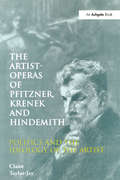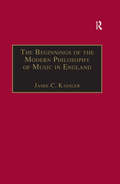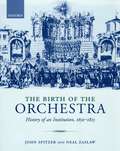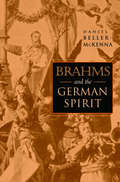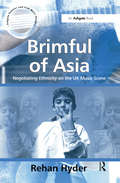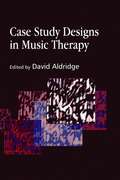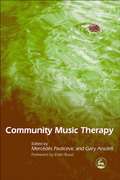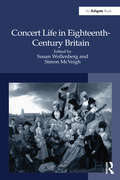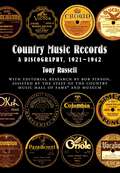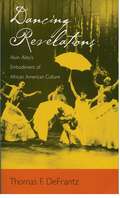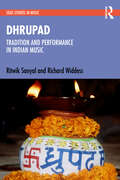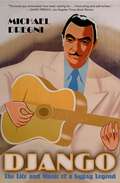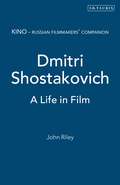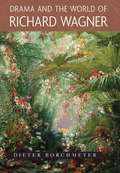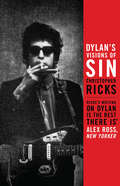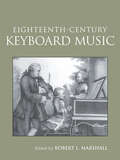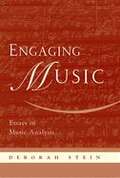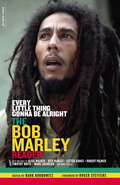- Table View
- List View
The Artist-Operas of Pfitzner, Krenek and Hindemith: Politics and the Ideology of the Artist
by Claire Taylor-JayThis is the first book-length study of the genre of 'artist-opera', in which the work's central character is an artist who is uncomfortable with his place in the world. It investigates how three such operas (Pfitzner's Palestrina (1915), Krenek's Jonny spielt auf (1926) and Hindemith's Mathis der Maler (1935)) contributed to the debate in early twentieth-century Germany about the place of art and the artist in modern society, and examines how far the artist-character may be taken as functioning as a persona for the real composer of the work. Because of their concern with the place of art within society, the works are also engaged with inherently political questions, and each opera is read in the light of the political context of its time: conservatism circa World War I, Americanism and democracy, and the rise of National Socialism.
The Beginnings of the Modern Philosophy of Music in England: Francis North's A Philosophical Essay of Musick (1677) with comments of Isaac Newton, Roger North and in the Philosophical Transactions
by Jamie C. KasslerIn 1677 a slim quarto volume was published anonymously as A Philosophical Essay of Musick. Written by Francis North (1637-85), chief justice of the Common Pleas, the Essay is in the form of a legal case argued from an hypothesis. Utilising the pendulum as his hypothesis, North provided a rationale from mechanics for the emerging new musical practice we now call 'tonality'. He also made auditory resonance the connecting link between acoustical events in the external world and the musical meanings the mind makes on the basis of sensory perception. Thus began the modern philosophy of music that culminated with the work of Hermann von Helmholtz. As a step towards understanding this tradition, Jamie C. Kassler examines the 1677 Essay in its historical context. After assessing three seventeenth-century criticisms of it and outlining how one critic developed some implications in the Essay, she summarises the basic principles that have guided the modern philosophy of music from its beginnings in the 1677 Essay. The book includes an annotated edition of the Essay as well as the comments of the three critics.
The Beginnings of the Modern Philosophy of Music in England: Francis North's A Philosophical Essay of Musick (1677) with comments of Isaac Newton, Roger North and in the Philosophical Transactions
by Jamie C. KasslerIn 1677 a slim quarto volume was published anonymously as A Philosophical Essay of Musick. Written by Francis North (1637-85), chief justice of the Common Pleas, the Essay is in the form of a legal case argued from an hypothesis. Utilising the pendulum as his hypothesis, North provided a rationale from mechanics for the emerging new musical practice we now call 'tonality'. He also made auditory resonance the connecting link between acoustical events in the external world and the musical meanings the mind makes on the basis of sensory perception. Thus began the modern philosophy of music that culminated with the work of Hermann von Helmholtz. As a step towards understanding this tradition, Jamie C. Kassler examines the 1677 Essay in its historical context. After assessing three seventeenth-century criticisms of it and outlining how one critic developed some implications in the Essay, she summarises the basic principles that have guided the modern philosophy of music from its beginnings in the 1677 Essay. The book includes an annotated edition of the Essay as well as the comments of the three critics.
The Birth of the Orchestra: History of an Institution, 1650-1815
by John Spitzer Neal ZaslawThis is the story of the orchestra, from 16th-century string bands to the "classical" orchestra of Haydn, Mozart, and Beethoven. Spitzer and Zaslaw document orchestral organization, instrumentation, social roles, repertories, and performance practices in Europe and the American colonies, concluding around 1800 with the widespread awareness of the orchestra as a central institution in European life.
Brahms and the German Spirit
by Daniel. Beller-McKennaThe music of Johannes Brahms is deeply colored, Daniel Beller-McKenna shows, by nineteenth-century German nationalism and by Lutheran religion. Focusing on the composer's choral works, the author offers new insight on the cultural grounding for Brahms's music. Music historians have been reluctant to address Brahms's Germanness, wary perhaps of fascist implications. Beller-McKenna counters this tendency; by giving an account of the intertwining of nationalism, politics, and religion that underlies major works, he restores Brahms to his place in nineteenth-century German culture. The author explores Brahms's interest in the folk element in old church music; the intense national pride expressed in works such as the Triumphlied; the ways Luther's Bible and Lutheranism are reflected in Brahms's music; and the composer's ideas about nation building. The final chapter looks at Brahms's nationalistic image as employed by the National Socialists, 1933-1945, and as witnessed earlier in the century (including the complication of rumors that Brahms was Jewish). In comparison to the overtly nationalist element in Wagner's music, the German elements in Brahms's style have been easy to overlook. This nuanced study uncovers those nationalistic elements, enriching our understanding both of Brahms's art and of German culture.
Brahms and the German Spirit (PDF)
by Daniel Beller-McKennaThe music of Johannes Brahms is deeply colored, Daniel Beller-McKenna shows, by nineteenth-century German nationalism and by Lutheran religion. Focusing on the composer's choral works, the author offers new insight on the cultural grounding for Brahms's music. Music historians have been reluctant to address Brahms's Germanness, wary perhaps of fascist implications. Beller-McKenna counters this tendency; by giving an account of the intertwining of nationalism, politics, and religion that underlies major works, he restores Brahms to his place in nineteenth-century German culture. The author explores Brahms's interest in the folk element in old church music; the intense national pride expressed in works such as the Triumphlied; the ways Luther's Bible and Lutheranism are reflected in Brahms's music; and the composer's ideas about nation building. The final chapter looks at Brahms's nationalistic image as employed by the National Socialists, 1933-1945, and as witnessed earlier in the century (including the complication of rumors that Brahms was Jewish). In comparison to the overtly nationalist element in Wagner's music, the German elements in Brahms's style have been easy to overlook. This nuanced study uncovers those nationalistic elements, enriching our understanding both of Brahms's art and of German culture.
Brimful of Asia: Negotiating Ethnicity on the UK Music Scene
by Rehan HyderDuring the 1990s, Asian pop artists began entering the mainstream of the British music industry for the first time. Bands such as Black Star Liner, Cornershop, Fun Da Mental and Voodoo Queens, led those within and without the industry to start asking questions such as what did it mean to be Asian? How did the bands' Asian background affect their music? What did their music say about Asians in Britain? In this book, Rehan Hyder draws on in-depth interviews with musicians from these bands and with critics and record producers, to examine the pressures associated with making music as a young Asian in today's multi-ethnic Britain. As the book reveals, these musicians wish to convey an authentic sense of creativity in their music, while at the same time wanting to assert a positive ethnic identity. Hyder explores these two impulses against the backdrop of a music industry and a society at large that hold a range of confining stereotypes about what it means to be Asian. The experiences of these bands add considerably to the wider debate about the nature of identity in the contemporary world.
Brimful of Asia: Negotiating Ethnicity on the UK Music Scene
by Rehan HyderDuring the 1990s, Asian pop artists began entering the mainstream of the British music industry for the first time. Bands such as Black Star Liner, Cornershop, Fun Da Mental and Voodoo Queens, led those within and without the industry to start asking questions such as what did it mean to be Asian? How did the bands' Asian background affect their music? What did their music say about Asians in Britain? In this book, Rehan Hyder draws on in-depth interviews with musicians from these bands and with critics and record producers, to examine the pressures associated with making music as a young Asian in today's multi-ethnic Britain. As the book reveals, these musicians wish to convey an authentic sense of creativity in their music, while at the same time wanting to assert a positive ethnic identity. Hyder explores these two impulses against the backdrop of a music industry and a society at large that hold a range of confining stereotypes about what it means to be Asian. The experiences of these bands add considerably to the wider debate about the nature of identity in the contemporary world.
Case Study Designs in Music Therapy (PDF)
by Cochavit Elefant David Aldridge Denise Grocke Gudrun Aldridge Hanne Mette Ridder Ochsner Tony WigramResearch and clinical work are often perceived as opposites in the field of music therapy. This book shows, for the first time, how these two areas of work can creatively complement one another, proving beneficial to both disciplines. Each chapter is written by a leading researcher and practitioner in the field, and the book covers a wide spectrum of approaches within different settings. Beginning with methodological and musicological approaches to case studies, the book then moves on to more specific topics such as the use of case studies in an interactive play setting and in music therapy with the elderly. Later chapters explore theoretical aspects, looking at a worked example of music and progressive change during therapy, and how case study designs can be used in practice. A must for all professionals working and studying within the music therapy area, this is also an informative and useful book for health researchers.
Community Music Therapy
by Mercedes Pavlicevic Gary AnsdellMusic therapists from around the world working in conventional and unconventional settings have offered their contributions to this exciting new book, presenting spirited discussion and practical examples of the ways music therapy can reflect and encourage social change. From working with traumatized refugees in Berlin, care-workers and HIV/AIDS orphans in South Africa, to adults with neurological disabilities in south-east England and children in paediatric hospitals in Norway, the contributors present their global perspectives on finding new ways forward in music therapy. Reflecting on traditional approaches in addition to these newer practices, the writers offer fresh perceptions on their identity and role as music therapists, their assumptions and attitudes about how music, people and context interact, the sites and boundaries to their work, and the new possibilities for music therapy in the 21st century. As the first book on the emerging area of Community Music Therapy, this book should be an essential and exciting read for music therapists, specialists and community musicians.
Community Music Therapy (PDF)
by Gary Ansdell Mercedes PavlicevicMusic therapists from around the world working in conventional and unconventional settings have offered their contributions to this exciting new book, presenting spirited discussion and practical examples of the ways music therapy can reflect and encourage social change. From working with traumatized refugees in Berlin, care-workers and HIV/AIDS orphans in South Africa, to adults with neurological disabilities in south-east England and children in paediatric hospitals in Norway, the contributors present their global perspectives on finding new ways forward in music therapy. Reflecting on traditional approaches in addition to these newer practices, the writers offer fresh perceptions on their identity and role as music therapists, their assumptions and attitudes about how music, people and context interact, the sites and boundaries to their work, and the new possibilities for music therapy in the 21st century. As the first book on the emerging area of Community Music Therapy, this book should be an essential and exciting read for music therapists, specialists and community musicians.
Concert Life in Eighteenth-Century Britain
by Susan WollenbergIn recent years there has been a considerable revival of interest in music in eighteenth-century Britain. This interest has now expanded beyond the consideration of composers and their music to include the performing institutions of the period and their relationship to the wider social scene. The collection of essays presented here offers a portrayal of concert life in Britain that contributes greatly to the wider understanding of social and cultural life in the eighteenth century. Music was not merely a pastime but was irrevocably linked with its social, political and literary contexts. The perspectives of performers, organisers, patrons, audiences, publishers, copyists and consumers are considered here in relation to the concert experience. All of the essays taken together construct an understanding of musical communities and the origins of the modern concert system. This is achieved by focusing on the development of music societies; the promotion of musical events; the mobility and advancement of musicians; systems of patronage; the social status of musicians; the repertoire performed and published; the role of women pianists and the 'topography' of concerts. In this way, the book will not only appeal to music specialists, but also to social and cultural historians.
Concert Life in Eighteenth-Century Britain
by Susan Wollenberg and Simon McVeighIn recent years there has been a considerable revival of interest in music in eighteenth-century Britain. This interest has now expanded beyond the consideration of composers and their music to include the performing institutions of the period and their relationship to the wider social scene. The collection of essays presented here offers a portrayal of concert life in Britain that contributes greatly to the wider understanding of social and cultural life in the eighteenth century. Music was not merely a pastime but was irrevocably linked with its social, political and literary contexts. The perspectives of performers, organisers, patrons, audiences, publishers, copyists and consumers are considered here in relation to the concert experience. All of the essays taken together construct an understanding of musical communities and the origins of the modern concert system. This is achieved by focusing on the development of music societies; the promotion of musical events; the mobility and advancement of musicians; systems of patronage; the social status of musicians; the repertoire performed and published; the role of women pianists and the 'topography' of concerts. In this way, the book will not only appeal to music specialists, but also to social and cultural historians.
Country Music Records: A Discography, 1921-1942
by Tony Russell Bob PinsonMore than twenty years in the making, Country Music Records documents all country music recording sessions from 1921 through 1942. With primary research based on files and session logs from record companies, interviews with surviving musicians, as well as the 200,000 recordings archived at the Country Music Hall of Fame and Museum's Frist Library and Archives, this notable work is the first compendium to accurately report the key details behind all the recording sessions of country music during the pre-World War II era. This discography documents--in alphabetical order by artist--every commercial country music recording, including unreleased sides, and indicates, as completely as possible, the musicians playing at every session, as well as instrumentation. This massive undertaking encompasses 2,500 artists, 5,000 session musicians, and 10,000 songs. Summary histories of each key record company are also provided, along with a bibliography. The discography includes indexes to all song titles and musicians listed.
Dancing Revelations: Alvin Ailey's Embodiment of African American Culture
by Thomas F. DeFrantzIn the early 1960s, the Alvin Ailey American Dance Theater was a small, multi-racial company of dancers that performed the works of its founding choreographer and other emerging artists. By the late 1960s, the company had become a well-known African American artistic group closely tied to the Civil Rights struggle. In Dancing Revelations, Thomas DeFrantz chronicles the troupe's journey from a small modern dance company to one of the premier institutions of African American culture. He not only charts this rise to national and international renown, but also contextualizes this progress within the civil rights, women's rights, and gay rights struggles of the late 20th century. DeFrantz examines the most celebrated Ailey dances, including Revelations, drawing on video recordings of Ailey's dances, published interviews, oral histories, and his own interviews with former Ailey company dancers. Through vivid descriptions and beautiful illustrations, DeFrantz reveals the relationship between Ailey's works and African American culture as a whole. He illuminates the dual achievement of Ailey as an artist and as an arts activist committed to developing an African American presence in dance. He also addresses concerns about how dance performance is documented, including issues around spectatorship and the display of sexuality, the relationship of Ailey's dances to civil rights activism, and the establishment and maintenance of a successful, large-scale Black Arts institution. Throughout Dancing Revelations, DeFrantz illustrates how Ailey combined elements of African dance with motifs adapted from blues, jazz, and Broadway to choreograph his dances. By re-interpreting these tropes of black culture in his original and well-received dances, DeFrantz argues that Ailey played a significant role in defining the African American cultural canon in the twentieth century. As the first book to examine the cultural sources and cultural impact of Ailey's work, Dancing Revelations is an important contribution to modern dance history and criticism as well as African-American studies.
Der Wahn des Gesamtkunstwerks: Richard Wagners politisch-ästhetische Utopie
by Udo Bermbach"Im Kunstwerk werden wir Eins sein", verheißt Richard Wagner. Leitmotivartig zieht sich dieser Satz durch Wagners Werk und seine Vision einer "ästhetischen Weltordnung". Kunst und Politik werden dabei untrennbar miteinander verwoben. Ein demokratisiertes Publikum soll ein Gesamtkunstwerk erleben, in dem die Einzelkünste zum Musikdrama verschmelzen. Wagner knüpft mit seinem Modell an die antike Polis an, die er idealtypisch in der Moderne wiederbeleben will. In die Neuauflage des revolutionären Wagner-Buchs lässt der Autor weitere überraschende und umfangreiche Analysen u.a. zu Wagners Antisemitismus einfließen.
Dhrupad: Tradition and Performance in Indian Music (SOAS Studies in Music)
by Ritwik Sanyal Richard WiddessDhrupad is believed to be the oldest style of classical vocal music performed today in North India. This detailed study of the genre considers the relationship between the oral tradition, its transmission from generation to generation, and its re-creation in performance. There is an overview of the historical development of the dhrupad tradition and its performance style from the sixteenth to the nineteenth centuries, and of the musical lineages that carried it forward into the twentieth century, followed by analyses of performance techniques, processes and styles. The authors examine the relationship between the structures provided by tradition and their realization by the performer to throw light on the nature of tradition and creativity in Indian music; and the book ends with an account of the ‘revival’ movement of the late twentieth century that re-established the genre in new contexts. Augmented with an analytical transcription of a complete dhrupad performance, this is the first book-length study of an Indian vocal genre to be co-authored by an Indian practitioner and a Western musicologist.
Django: The Life and Music of a Gypsy Legend
by Michael DregniDjango Reinhardt was arguably the greatest guitarist who ever lived, an important influence on Les Paul, Charlie Christian, B.B. King, Jerry Garcia, Chet Atkins, and many others. Yet there is no major biography of Reinhardt. Now, in Django, Michael Dregni offers a definitive portrait of this great guitarist. Handsome, charismatic, childlike, and unpredictable, Reinhardt was a character out of a picaresque novel. Born in a gypsy caravan at a crossroads in Belgium, he was almost killed in a freak fire that burned half of his body and left his left hand twisted into a claw. But with this maimed left hand flying over the frets and his right hand plucking at dizzying speed, Django became Europe's most famous jazz musician, commanding exorbitant fees--and spending the money as fast as he made it. Dregni not only chronicles this remarkably colorful life--including a fascinating account of gypsy culture--but he also sheds much light on Django's musicianship. He examines his long musical partnership with violinist Stéphane Grappelli--the one suave and smooth, the other sharper and more dissonant--and he traces the evolution of their novel string jazz ensemble, Quintette du Hot Club de France. Indeed, the author spotlights Django's amazing musical diversity, describing his swing-styled Nouveau Quintette, his big band Django's Music, and his later bebop ensemble, as well as his many compositions, including symphonic pieces influenced by Ravel and Debussy and his unfinished organ mass inspired by Bach. And along the way, the author offers vivid snapshots of the jazz scene in Paris--colorful portraits of Josephine Baker, Bricktop, Louis Armstrong, Coleman Hawkins, and countless others--and of Django's vagabond wanderings around France, Europe, and the United States, where he toured with Duke Ellington. Capturing the extraordinary life and times of one of the great musicians of the twentieth century, Django is a must-read portrait of a true original.
Dmitri Shostakovich: A Life in Film (KINO - Russian Filmmakers' Companions)
by John RileyOf all the major Soviet composers who worked in the cinema, the most prominent was Dmitri Shostakovich who, in addition to over a hundred works for the stage and concert hall, wrote scores for almost forty films. Yet despite his reputation this work, when not completely overlooked, has been poorly judged by the same criteria as his other music. Likewise, while much attention has been paid to Soviet film, the crucial role played by the scores is all too often forgotten. This, the first book in English to look at Shostakovich's cinema career, discusses every film he scored, looking at the films themselves, tracing their relationship to the changing concerns and policies of the Soviet state and examining how the music works in context. John Riley also gives a fascinating account of the composer's life. This highly readable book will be welcomed equally by devotees of the composer; those interested in Soviet culture and cinema; and general film music enthusiasts.
Drama and the World of Richard Wagner (PDF)
by Dieter Borchmeyer Daphne EllisRichard Wagner continues to be the most controversial artist in history, a perpetually troubling figure in our cultural consciousness. The unceasing debate over his works and their impact--for and against--is one reason why there has been no genuinely comprehensive modern account of his musical dramas until now. Dieter Borchmeyer's book is the first to present an overall picture of these musical dramas from the standpoint of literary and theatrical history. It extends from the composer's early works--still largely ignored--to the Ring Cycle and Parsifal, and includes Wagner's unfinished works and operas he never set to music. Through lively prose, we come to see Wagner as a librettist--and as a man of letters--rather than primarily as musical composer.Borchmeyer uncovers a vast field of cultural and historical cross-references in Wagner's works. In the first part of the book, he sets out in search of the various archetypal scenes, opening up the composer's dramatic workshop to the reader. He covers all of Wagner's operas, from early juvenilia to the canonical later works.The second part examines Wagner in relation to political figures including King Ludwig II and Bismarck, and, importantly, in light of critical reactions by literary giants--Thomas Mann, whom Borchmeyer calls "a guiding light in this exploration of the fields that Wagner tilled," and Nietzsche, whose appeal to "philology" is a key source of inspiration in attempts to grapple with Wagner's works.For more than twenty years, Borchmeyer has placed his scholarship at the service of the famed Bayreuth Festival. With this volume, he gives us a summation of decades of engagement with the phenomenon of Wagner and, at the same time, the result of an abiding critical passion for his works.
Dylan's Visions of Sin
by Christopher Ricks‘I consider myself a poet first and a musician second’ ‘It ain’t the melodies that’re important man, it’s the words’ Two quotes from Dylan himself that underline the importance of this book. Dylanology thrives. There is no shortage of books about him and many of them will be dusted off for his 70th birthday. This one, however, stands on its own both for its unusual approach and for the virtuosity of its execution. Ricks’s scheme, aptly, is to examine Dylan’s songs through the biblical concepts of the seven deadly Sins, the four Virtues, and the three Heavenly Graces. He carries it off with panache. Ricks may be the most eminent literary critic of his generation but nobody should feel his book is one of earnest, unapproachable exegesis, on the contrary it has a flamboyance, almost effervescence about it that is captivating. Ricks boldly and successfully judges Dylan as a poet not a lyricist and in his tour-de-force makes endless illuminating comparisons with canonical writers such as Eliot, Hardy, Hopkins and Larkin.
Eighteenth-Century Keyboard Music
by Robert MarshallFirst published in 2004. Routledge is an imprint of Taylor & Francis, an informa company.
Eighteenth-Century Keyboard Music
by Robert L. MarshallFirst published in 2004. Routledge is an imprint of Taylor & Francis, an informa company.
Every Little Thing Gonna Be Alright: The Bob Marley Reader
by Hank BordowitzThroughout Africa, the Caribbean, Europe, and America, Bob Marley represents far more than just the musician who translated spiritual and political beliefs into hypnotic, hard-hitting songs such as "Get Up, Stand Up," "No Woman, No Cry," and "Jammin'." Marley was born in rural Jamaica and reared in the mean streets of Kingston's Trenchtown; his ascent to worldwide acclaim, first with The Wailers--Peter Tosh and Bunny Livingstone--and later as a solo artist, is a riveting story of the spiritual awakening of a uniquely talented individual.Now, for the first time, a symphony of voices has joined together to offer perspective on one of this century's most compelling figures. Dealing with Bob Marley as a man and myth, from his "rude boy" teens to international fame and his tragic death at the age of thirty-six, Every Little Thing Gonna Be Alright then explores the larger picture, examining Marley as the spokesman for Jamaica's homegrown religion of Rastafarianism, as a flash point for the pressure cooker of Jamaican politics, and his unique status as the first pop musical superstar of the so-called "Third World."
